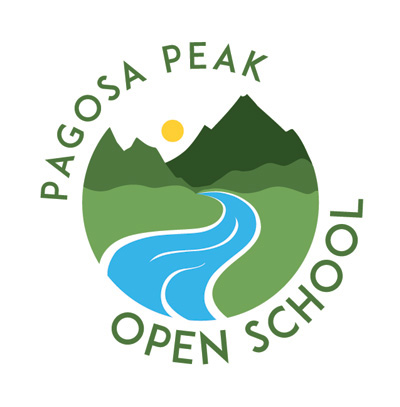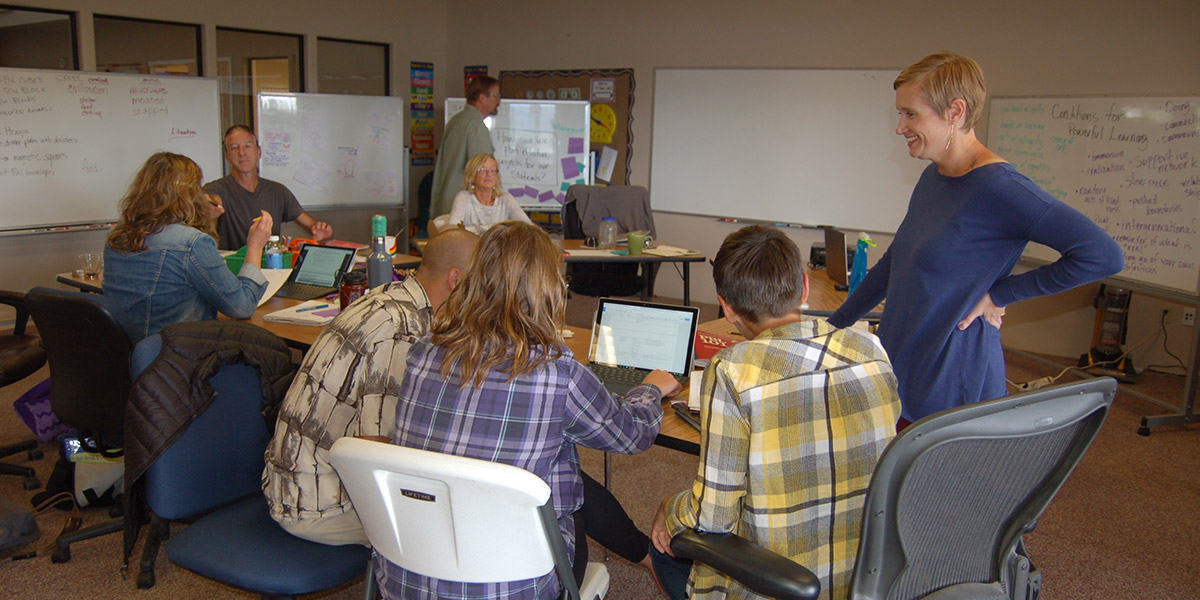Erin Sanchez, a member of the national faculty with the Buck Institute for Education — BIE, for short — was in the midst of her training process with the new staff at the Pagosa Peak Open School, and after a quick bite of lunch, she joined me at one of the two picnic tables on the “back porch” of the Parelli Building for an interview about Project-Based Learning — PBL, for short. We had talked a bit about her years as a high school and continuing education teacher, and as a national PBL coach.
As we discussed the challenges of providing a “place-based” education to young students in rural Colorado, Erin remarked on the unique view from the Parelli Building’s back porch.
“It’s funny. This is the first school I’ve worked with, where I’m looking out over a meadow, a lake, and a Walmart.
“But you know, the beauty of place-based learning — even in very rural areas — you can still find ways to connect the students to the community. It’s bringing in experts into the school, and going out and meeting folks who are innovating.
“And the natural environment. I mean, you have no end to the resources there.”
Ms. Sanchez is no stranger to rural schools. She was part of the team of teachers and parents who opened one of the first Project-Based Learning schools in the U.S. — the Minnesota New Country School, in Henderson, Minnesota. A town of 739 people.
“The town had lost its hometown high school to the big consolidations, in the late 1980s.” The students were being bused to a “big city school.” Not everyone in the town was happy about that situation.
“So some parents and teachers got together a designed a new high school — and they really went through all the structures of a typical school, and asked, ‘Why do school operate this way? Like, why do we have bells?’ And when they couldn’t come up with a rationale that fit the 21st century, they threw out the bells. And they did the same thing with ‘classes.’ And they did the same thing with ‘teachers.’
“And what they ended up with was this very open model of students designing projects from their own passions, and carrying them out in the community. And presenting to a public audience within the township.
“That school has been in existence for over 25 years. That’s where I started my teaching career — and it spoiled me to teach anywhere else.”
She smiled.
This same process of questioning the operations of typical American schools — asking, “Why bells? Why teachers? Is there a better way?” — took place here in Pagosa Springs over the past two-and-a-half years, when the Pagosa Charter School Initiative board began visiting innovative, successful school all around Colorado and northern New Mexico, looking for educational models that “fit the 21st century.”
The founding board ultimately settled on two closely related educational approaches — Project-Based Learning and Place-Based Education — as the ones that could best meet the needs of Archuleta County families, and that could attract a committed, innovative staff. That decision led to a relationship with new School Director James Lewicki, and with BIE as an organization that could provide the necessary staff training for Pagosa’s new PBL-centered school.
Erin eventually left the classroom and began working as a consultant and trainer with EdVisions Schools, which helped schools develop student-based PBL models — learning situations where students themselves design their own educational pathways. EdVisions also focused on the creation of a support network that allowed schools to share ideas and resources. That work then led her to BIE.
“I eventually made my way to the Buck Institute about seven years ago. I was very familiar with them, but they are kind of the ‘other end’ of the PBL spectrum — where the teachers are designing the projects and aligning them to state standards, and most of the learning takes place within the four walls of the classroom.
“That’s just a necessity, when working in more traditional environments.”
Certainly, American education takes place within a ‘spectrum’ — ranging from administration-led ‘top down’ to student-led ‘bottom up’ — and everything in between. As Pagosa’s first District-approved charter school, Pagosa Peak will be finding and establishing its place within that spectrum.
A good deal of the ‘top-down’ direction within the current education scene is a result of “standards-based education.” The Colorado State Board of Education fully adopted the controversial “Common Core” standards back in 2010, partly as a result of pressure from the Obama administration and its approach to the federal “No Child Left Behind” legislation.
According to Ms. Sanchez, Project-Based Learning has certain advantages over other educational approaches in a state, like Colorado, that has embraced ‘Common Core.’ In its beginning stages, the projects at Pagosa Peak Open School are going to be designed by the staff, to align with student interests but also in alignment with state standards.
“From the inception of the project idea, it will be, ‘What do we want students to know? And be able to do?’ So the standards will be the building blocks for each project — and in particular, we look at standards that really need ‘application.’
“I mean, there are standards that are simply about acquisition of knowledge. But for the most part, what traditional schools miss is the ‘application’ of that knowledge. So, through a project, you are both acquiring the knowledge, and learning how to apply it. And usually, you will be creating some kind of tangible product, to demonstrate what you know.”
As we sat at the picnic table talking about this new school, Erin and I were looking out — not only at a meadow, and a lake, and a Walmart — but also, closer at hand, at the one-acre school playground now in the process of development. Our idea for the playground is not of a static landscape designed by an architect, but rather that the landscape will be alive and changing as a result of student projects. Many of those projects will include garden areas, or new play structures, or student-built seating areas, or perhaps sculptures.
I’m part of a small team of volunteers currently in the processes of constructing a fence around the main playground/landscape area, to define a safe area for the younger children. None of us are experienced fence-builders, so the process of constructing the fence has been a learning process — a process of acquiring knowledge and learning how to apply it, to achieve a real-world result.
The entire process of developing the Pagosa Peak Open School — doing the research into educational models, learning how to operate as a functional non-profit board, writing grants, getting School District approval for our 450-page application, developing the first year budget, negotiating a lease on a facility —the entire process has been a matter of acquiring knowledge and learning how to apply it. The school itself has been an example of real-world ‘Project-Based Learning.’
Isn’t this exactly the process of any useful, creative work?
And isn’t this exactly the process we want our children to understand and feel comfortable with, as they move into adulthood?



